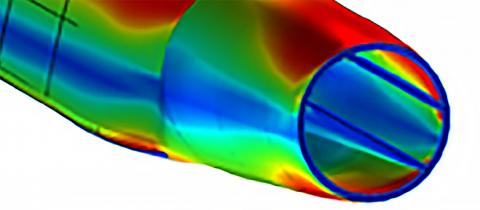
Digital twin: a virtual image which can predict the future
(This article was originally published in L'Édition N.19)
Through numerical modelling and data input, scientists at Université Paris-Saclay can predict the behaviour of a real system and anticipate variations.
Digital twins are relative newcomers to the manufacturing world, yet they promise to change the way things are done. The result of a combination of simulation and data, they provide the digital image of a real system (machine, part or process) which they model as faithfully as possible. Thanks to digital twins, predicting the functioning of a system and finding new ways of operation become possible. Digital twins are the focus of research being carried out at several laboratories at Université Paris-Saclay, including the Mechanics Laboratory Paris-Saclay (LMPS – Univ. Paris- Saclay, CentraleSupélec, ENS Paris-Saclay, CNRS).
A loop of information exchange
To develop this hyper-realistic modelling, scientists use physical models, such as those of continuum mechanics, which they enrich with data from real life provided by sensors placed at the level of the system. However, a digital twin is not simply a virtual and static copy of a system. The model evolves according to the information collected. These include Dynamic Data Driven Applications Systems or DDDAS. In this case, the real system and the digital twin continuously and actively communicate with each other. “The physical system sends experimental data to the digital twin via the sensors. This allows the model to be recalibrated if the real system changes or deviates from its assumed functioning,” explains Ludovic Chamoin, who leads the STAN team at LMPS and who is familiar with this feedback loop. “The digital twin becomes able to predict what will happen before it happens. This facilitates decision making and avoids entering a critical area of system operation.”
The challenge is to get the most suitable model possible. “If the model is too complicated, it’ll be difficult to run the simulation and make predictions in a reasonable time. On the other hand, if it’s too simple, we’ll understand nothing of the phenomenon studied.”
Anticipating the behaviour to damage
Ludovic Chamoin and his colleagues at LMPS are interested in the behaviour of mechanical structures made of concrete or composite materials which are subjected to damage processes. Together with the Mechanical and Thermal Research Department (SEMT – Univ. Paris-Saclay, CEA), his team has recently applied a dynamic model updating strategy during seismic testing on a shaking table. “As the building model was damaged during the test, its properties changed. The control law, which was based on a sound structure, gradually lost its effectiveness and this compromised the way the vibration table was controlled, leading to the risk of instability.” Thanks to accelerometers placed on the structure, measurements were added to the model in order to modify the control law on the go and to take into account the evolution of the structure. “The idea is to not stop testing but instead to assess the damage to the structure continuously and in real time.”
The DREAM-ON project, which won an ERC Consolidator Grant in 2021, aims to go even further and look at smart, connected mechanical structures which can monitor their health and adapt autonomously during use. In this case, an array of distortion-sensitive optical fibres is embedded in the material. “This ‘on-board’ aspect makes it possible to have real time access to what’s happening in the structure with a very high spatial resolution,” says Ludovic Chamoin.
Ultimately, DREAM-ON plans to provide a proof of concept in the form of an experiment where the integrity of a real structure under controlled loading is preserved. One of the difficulties lies in the processing of the signal as the model must be recalibrated in real time. “We’d like to achieve a prediction in the region of one second.” To achieve this, the team is relying on artificial intelligence (AI). “We start with a fairly simple law of behaviour which is representative of what is happening, and the AI adds what we don’t know and cannot model analytically. This is learnt through machine learning, combining knowledge from engineering and materials science, thermodynamics and the laws of fundamental physics.”
The applications are mainly in the field of wind turbines. “All those structures which can get damaged randomly,” sums up Ludovic Chamoin. “We want to know when to act, and not to do it too soon because we want to put this type of structure out of action as little as possible.”
Publications :
- L. Chamoin, DREAM-ON: merging advanced sensing techniques and simulation tools for future Structural Health Monitoring technologies. The Project Repository Journal, 10, 124–127 (2021).
- A. Bénady, L. Chamoin, E. Baranger. Intégrer les connaissances physiques dans les réseaux de neurones: application à l’apprentissage des lois de comportement matériaux à partir de mesures de déformation par fibres optiques. La Revue 3E.I - Intelligence Artificielle et Génie Electrique, Société de l’électricité, de l’électronique et des technologies de l’information et de la communication, n°109 (2022)
- L. Chamoin, S. Farahbakhsh, M. Poncelet. An educational review on distributed optic fiber sensing based on Rayleigh backscattering for damage tracking and structural health monitoring. Measurement Science & Technology, 33, (2022)
- M. Diaz, P-E. Charbonnel, L. Chamoin. A new Kalman filter approach for structural parameter track- ing: application to the monitoring of damaging structures tested on shaking tables. Mechanical Systems and Signal Processing, vol. 182 (2023).
